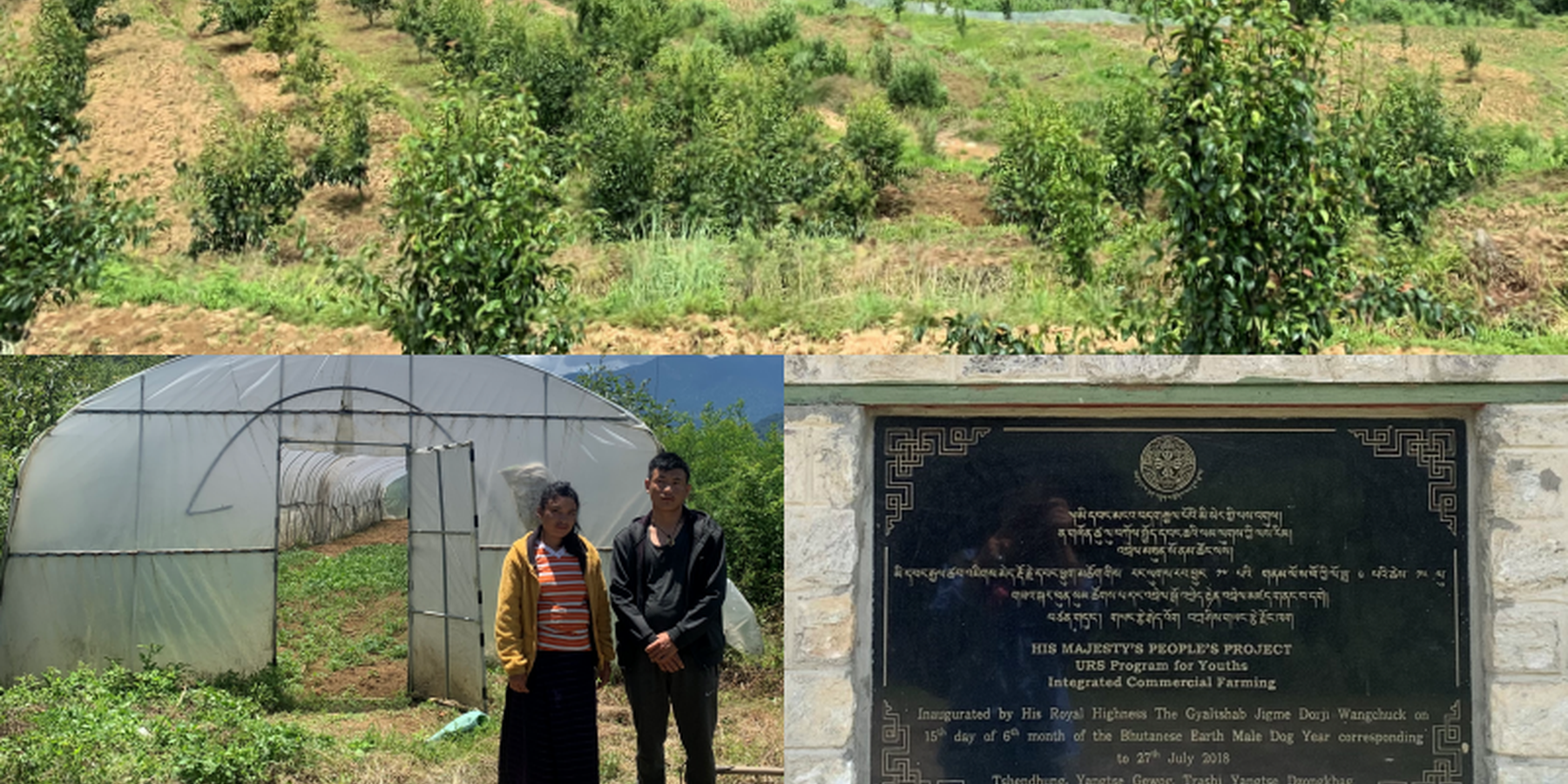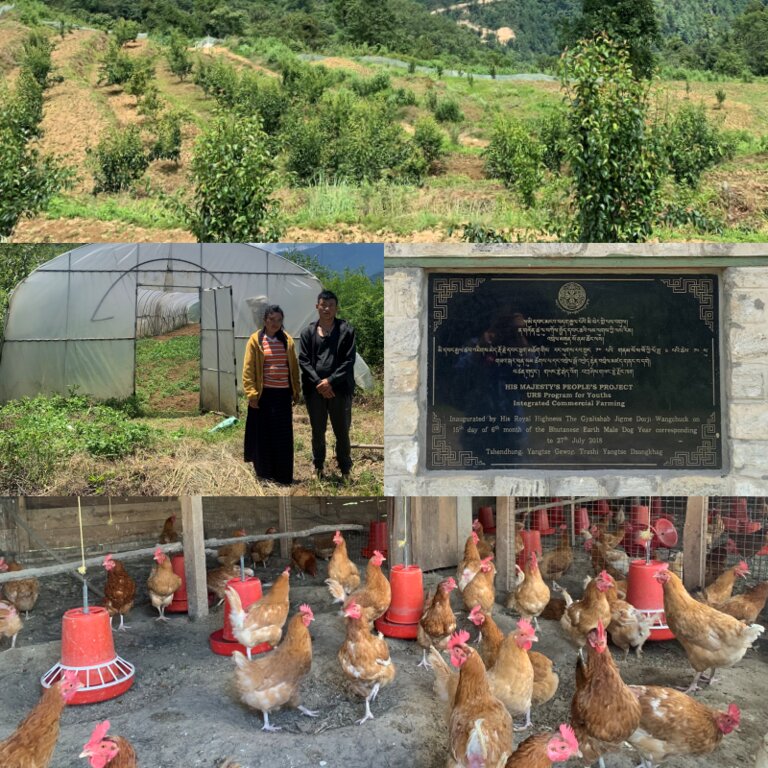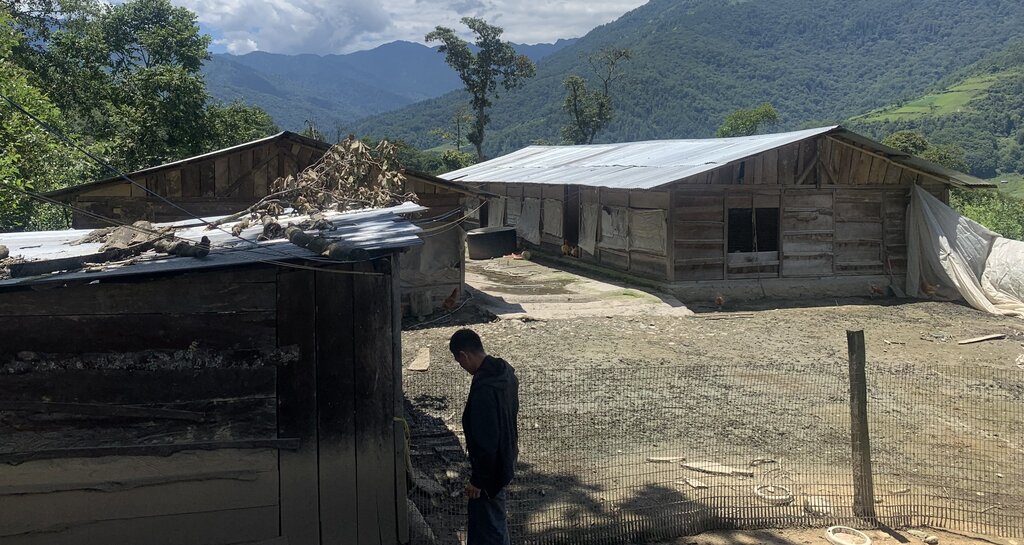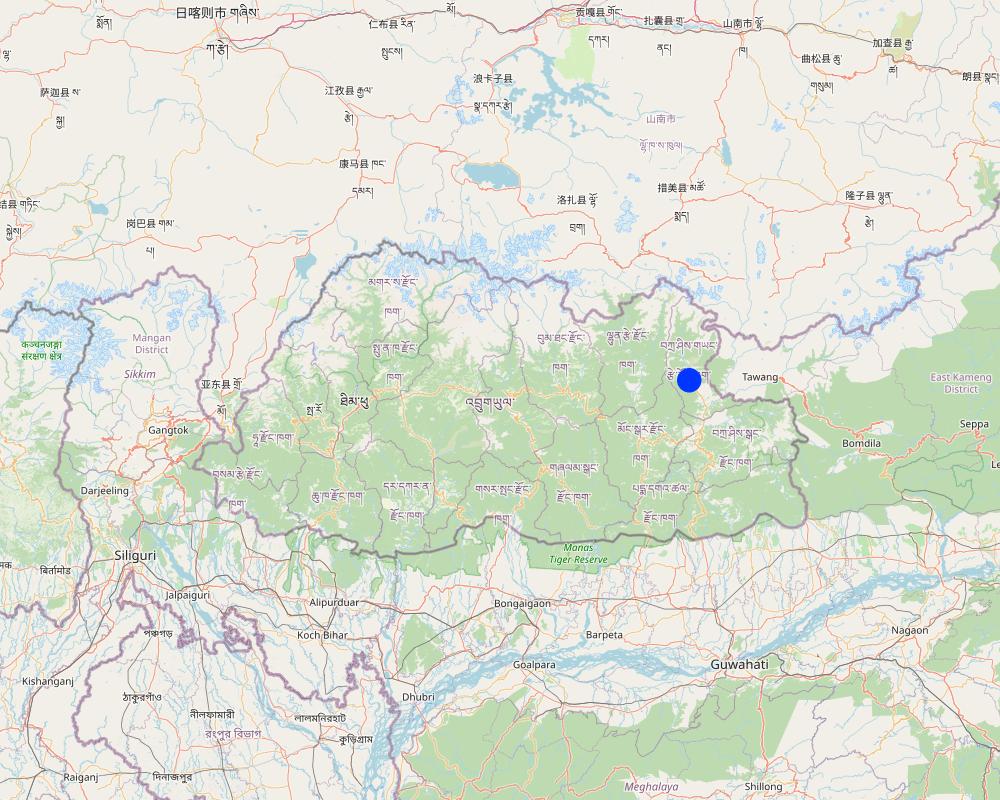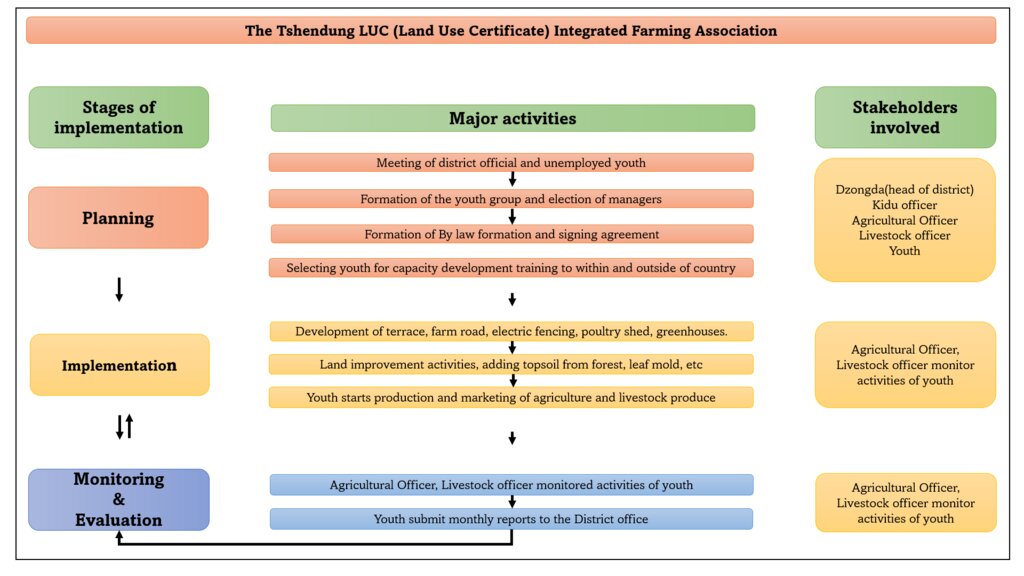Land Use Certificate to engage youth in Agriculture [Bhutan]
- Creation:
- Update:
- Compiler: ONGPO LEPCHA
- Editor: chenga Tshering
- Reviewers: William Critchley, Rima Mekdaschi Studer
'Sa cha Kelchay Lakher'
approaches_6886 - Bhutan
View sections
Expand all Collapse all1. General information
1.2 Contact details of resource persons and institutions involved in the assessment and documentation of the Approach
Key resource person(s)
land user:
Tenzin Kuenzang
17582178
Tshendung, Lichen Chiwog, Yangtse gewog
Bhutan
land user:
Wangmo Sither
17459445
Tshendung, Lichen Chiwog, Yangtse gewog
Bhutan
Name of project which facilitated the documentation/ evaluation of the Approach (if relevant)
Strengthening national-level institutional and professional capacities of country Parties towards enhanced UNCCD monitoring and reporting – GEF 7 EA Umbrella II (GEF 7 UNCCD Enabling Activities_Umbrella II)Name of the institution(s) which facilitated the documentation/ evaluation of the Approach (if relevant)
National Soil Services Centre, Department of Agriculture, Ministry of Agriculture & Livestock (NSSC) - Bhutan1.3 Conditions regarding the use of data documented through WOCAT
When were the data compiled (in the field)?
19/07/2023
The compiler and key resource person(s) accept the conditions regarding the use of data documented through WOCAT:
Ja
2. Description of the SLM Approach
2.1 Short description of the Approach
The Land Use Certification (LUC) commenced in 2015 as the new allocation system for land and provided a new title of land tenure. Initially, LUC focused on allotting land to Government institutions and Gerab Dratshang (monastic bodies). However, LUC later focused on the unemployed youth who were interested in commercial farming.
2.2 Detailed description of the Approach
Detailed description of the Approach:
The Land Use Certification (LUC) commenced in 2015 as the new system for the allocation of land and a new title of land tenure. Initially, LUC focused on allotting land to Government institutions and Gerab Dratshang (monastic bodies). However, LUC later focused on the unemployed youth who were interested in commercial farming. This documentation is based on the LUC group ‘Tshendung LUC Integrated Farming Association'.
The main aims of the LUC approach are 1) to help sustainably manage and enhance productive use of land, 2) to encourage next-generation farming through farm mechanization and large-scale enterprising farming, and 3) to enhance the rural economy.
The approach started as an initiative towards the realization of the noble vision of strengthening sovereignty and security and enhancing social policy of equity and the national objective of self-reliance. Unemployed youth groups are expected to help sustainably manage and enhance the productive use of land - and the approach was to encourage next-generation farming through farm mechanization and large-scale production to promote enterprise-based farming and enhance the rural economy. Initially, it started with a meeting between district officials and unemployed youth. Later, bylaws were created, and agreements were signed. This was followed by sending youth for capacity development within and outside the country. They were trained on how to operate power tillers, use grass cutters and chain saws, and on the installation of electric fencing and greenhouses. In addition, they were trained in how to grow vegetables, fruit crops, and livestock production. In parallel infrastructure development activities were taking place in the current project sites.
The Tshendung LUC Integrated Farming Association enables land users to carry out agricultural activities more effectively. In addition, the association was able to transport and market their produce more efficiently than individual households. Other co-benefits reported are the improved community sense and enhanced social cohesion because the exchange of experiences and collaboration builds mutual trust. Working in a group eases hard physical work on the 9 acres (3.6 ha) of land.
The District Office initiated the group formation upon command from higher authority. They were also involved in planning, forming groups, bylaws, and monitoring the activities of the group. The District agricultural and livestock officers provided technical guidance on crop and livestock production. They also provided them with agricultural inputs. Lichen Primary School are consumers of the agricultural and livestock goods produced by the group. Land users are involved in planning the production and marketing of agricultural and animal products.
Initially, there were 11 youths in the group. They were provided with wide-ranging training and support including the preparation of land for growing crops and the construction of their residence. In addition to agricultural inputs like seeds, and saplings, the group was also provided farm machinery and farm tools for easy implementation of farm works. The group is happy with all the initiatives the government has done, however, one thing that discouraged the group from continuing with farming activities was the location of the site. They didn't like the location - which is in the middle of the forest around 15-20km away from the town. This makes transportation of agricultural inputs like seeds and feeds and marketing of agricultural and livestock products very difficult. The government initially supported the group with everything but later this support was withdrawn, which made it very difficult for the group to survive on their own.
2.3 Photos of the Approach
2.5 Country/ region/ locations where the Approach has been applied
Country:
Bhutan
Region/ State/ Province:
Lichen, Trashi Yangtse: Bhutan
Further specification of location:
Tshendung, Lichen chiwog (village), Yangtse gewog (sub district): Trashi Yangtse Dzongkhag (District)
Map
×2.6 Dates of initiation and termination of the Approach
Indicate year of initiation:
2015
If precise year is not known, indicate approximate date when the Approach was initiated:
less than 10 years ago (recently)
Comments:
The Land Use Certification (LUC) is an initiative commenced in 2015 as the new allotment system of land and a new title of land tenure.
2.7 Type of Approach
- recent local initiative/ innovative
2.8 Main aims/ objectives of the Approach
The main aims/objectives of the approach are to 1) foster youth entrepreneurship in the country, 2) promote, foster, encourage, and assist the efficient, convenient marketing and distribution of agricultural products, livestock, and associated by-products with the growing market within Trashi Yangtse and other districts in the country.
2.9 Conditions enabling or hindering implementation of the Technology/ Technologies applied under the Approach
social/ cultural/ religious norms and values
- enabling
Land users are generally from the same local ethnic groups called Yangtsepa. They shared the same social, cultural, religious, norms and values. Gender equality is considered and importance and priority is given equally.
availability/ access to financial resources and services
- hindering
Initially, land users were provided all required support by the project including financial support, however, when the land users started implementing and working on the approach own their own. Getting financial support was difficult.
institutional setting
- hindering
Initially, there were 11 land users involved, however, today only two of the land users are active. Shortage of human resources hinders production and this result in low profit.
collaboration/ coordination of actors
- hindering
Although the land users are able to produce a certain quantity of vegetables there are not many collaborators willing to buy their produce. They also lack a farm manager who can dedicate 100% of his time in marketing and finding collaborators.
knowledge about SLM, access to technical support
- enabling
Technical support related to agriculture and livestock is provided by the District Agriculture officer and livestock officers. Inputs like seeds are also freely provided by the district. The activities are also monitored by the officers and advices are given if land users are doing thing wrongly.
markets (to purchase inputs, sell products) and prices
- hindering
The site of the approach is located very far from the market. The size of the market is very small with lots of other competitors like farmers groups i.e., Vegetable group, milk group, etc. And due to this competition, the prices the land users get are very low.
workload, availability of manpower
- hindering
Totally, there are about 9 acres of land and there are only two land users who are active and working in the land. The workload is too much and this affects their production.
3. Participation and roles of stakeholders involved
3.1 Stakeholders involved in the Approach and their roles
- local land users/ local communities
Youth from local communities
They are the land users on the project site.
- SLM specialists/ agricultural advisers
District Agriculture and Livestock officers
Advisors: All technical supports related to the production of crops and livestock are provided by these officers.
- teachers/ school children/ students
Lichen Primary School
Consumers: Vegetables produced by the land users are sold to the school.
- national government (planners, decision-makers)
District head office
Decision makers: provide technical support and financial support. involved in the planning and implementation of the activities under the approach.
3.2 Involvement of local land users/ local communities in the different phases of the Approach
| Involvement of local land users/ local communities | Specify who was involved and describe activities | |
|---|---|---|
| initiation/ motivation | external support | District officer, Kidu officer directed the youths on the opportunity through this approach. |
| planning | interactive | The district officer, engineer, agricultural and livestock extension officer, head of the gewog/block, and land users identified the place and started the planning. |
| implementation | interactive | The district engineer started the land development activities by creating a terrace and farm road. This was later followed by agricultural and livestock activities. |
| monitoring/ evaluation | interactive | Focal person for LUC Agriculture extension officer Livestock extension officer District legal officer |
3.3 Flow chart (if available)
Description:
Flow chart of the major events that took place before youth started taking care of the land. Also indicates different phase of approach and stakeholders involved.
Author:
Ongpo Lepcha
3.4 Decision-making on the selection of SLM Technology/ Technologies
Specify who decided on the selection of the Technology/ Technologies to be implemented:
- land users alone (self-initiative)
Explain:
Initially, a part of electric fencing was done by the government, and later the group installed a part of greenhouse. Chicken manure and leaf mould, and top soil from the forest were collected and applied.
Specify on what basis decisions were made:
- personal experience and opinions (undocumented)
4. Technical support, capacity building, and knowledge management
4.1 Capacity building/ training
Was training provided to land users/ other stakeholders?
Ja
Specify who was trained:
- land users
If relevant, specify gender, age, status, ethnicity, etc.
10 males and a female were trained. They were all under the age of 25.
Form of training:
- farmer-to-farmer
- demonstration areas
Subjects covered:
Production of fruits and vegetables, Poultry and dairy production, Power tiller operation, and record keeping.
Comments:
Land users were sent to India for the site visit to explore and learn about poultry production, dairy production, and vegetable and fruit production. Some of them attended training on how to operate power tillers.
4.2 Advisory service
Do land users have access to an advisory service?
Ja
Specify whether advisory service is provided:
- on land users' fields
- at permanent centres
Describe/ comments:
The agricultural extension officer and livestock officer provided advice on what crop to grow, and what livestock to rear.
4.3 Institution strengthening (organizational development)
Have institutions been established or strengthened through the Approach?
- yes, moderately
Specify the level(s) at which institutions have been strengthened or established:
- local
Describe institution, roles and responsibilities, members, etc.
Institutional strengthening between the group and the Lichen Primary School was strengthened. Here the group is a producer of vegetables, butter, and cheese and the school is the buyer.
4.4 Monitoring and evaluation
Is monitoring and evaluation part of the Approach?
Ja
Comments:
Crop and livestock production were monitored through observation by the agricultural officer and livestock officer.
If yes, is this documentation intended to be used for monitoring and evaluation?
Ja
4.5 Research
Was research part of the Approach?
Ja
Specify topics:
- economics / marketing
- technology
Give further details and indicate who did the research:
The research was conducted to study the feasibility of different vegetables in different seasons. Trials were conducted and land users found out that most vegetables don't do well except vegetables like cabbage, beans, and chilli.
5. Financing and external material support
5.1 Annual budget for the SLM component of the Approach
Comments (e.g. main sources of funding/ major donors):
There is no budget allocated for any SLM technologies in this approach. All financial needs were met by the project.
5.2 Financial/ material support provided to land users
Did land users receive financial/ material support for implementing the Technology/ Technologies?
Ja
If yes, specify type(s) of support, conditions, and provider(s):
Construction support: Road constructed by project, land development done by project
Constructional material support: Electric fencing, housing, Irrigation, greenhouse, power tillers, power chain, grass cutter, wheelbarrow, secateurs, spades, shovels, etc.
5.3 Subsidies for specific inputs (including labour)
- equipment
| Specify which inputs were subsidised | To which extent | Specify subsidies |
|---|---|---|
| machinery | fully financed | The cost for 3 power tillers, 3 power tillers, 3 grass cutters, and 1 chaffer is all provided by the project for free. |
| tools | fully financed | Tools like spades, secateurs, shovels, spade, sickle, rake, pruning saw, wheelbarrow, knife, |
- agricultural
| Specify which inputs were subsidised | To which extent | Specify subsidies |
|---|---|---|
| seeds | fully financed | Vegetable seeds were provided free by the project |
| fertilizers | fully financed | Suphala were initially provided for free. |
- construction
| Specify which inputs were subsidised | To which extent | Specify subsidies |
|---|---|---|
| roads | fully financed | The cost involved in road and land development was paid by the project. |
| House | fully financed | All materials used for making house and stores were provided by the project. |
- infrastructure
| Specify which inputs were subsidised | To which extent | Specify subsidies |
|---|
If labour by land users was a substantial input, was it:
- rewarded with other material support
Comments:
Land users (youth) worked in the group for the installation of the greenhouse, electric fencing, construction of a poultry shed, and apartment bungalow for themselves.
5.4 Credit
Was credit provided under the Approach for SLM activities?
Nee
5.5 Other incentives or instruments
Were other incentives or instruments used to promote implementation of SLM Technologies?
Ja
If yes, specify:
Land development was carried out under the supervision of the District Agricultural and livestock officers, who are SLM experts at the district level. Greenhouses with simi automated irrigation, terraces with bunds, and electric fencing were promoted as incentives through the project.
6. Impact analysis and concluding statements
6.1 Impacts of the Approach
Did the Approach empower local land users, improve stakeholder participation?
- No
- Yes, little
- Yes, moderately
- Yes, greatly
Land users received various training which helped them equip with knowledge and skills related to the use of agricultural machinery like power tillers, grass cutters, and chaffer machines. In addition, they also learned how to grow vegetables and fruits scientifically.
Did the Approach enable evidence-based decision-making?
- No
- Yes, little
- Yes, moderately
- Yes, greatly
Land users initially practiced growing crops based on the local communities, however, later they learned to do off-season vegetables using a greenhouse, and the vegetables they grew were all based on the evidence that some vegetables are not doing good in the location.
Did the Approach help land users to implement and maintain SLM Technologies?
- No
- Yes, little
- Yes, moderately
- Yes, greatly
The site of the approach is located away from local communities. Using technologies like electric fencing became very important. The land user also shared their view on aspects and slopes of the land and their activities like maintaining the slope and fertility of the land. Land user also added that they were taught how to grow Napier grass to reduce land degradation.
Did the Approach improve knowledge and capacities of land users to implement SLM?
- No
- Yes, little
- Yes, moderately
- Yes, greatly
Land users received various training which helped them equip with knowledge and skills related to the use of agricultural machinery like power tillers, grass cutters, and chaffer machines. In addition, they also learned how to grow vegetables and fruits scientifically. This knowledge and skills indirectly helped them to maintain soil fertility and increase production.
Did the Approach empower socially and economically disadvantaged groups?
- No
- Yes, little
- Yes, moderately
- Yes, greatly
Land users were mostly unemployed youths from nearby villages. They were sons and daughters of socially and economically disadvantaged groups. Some of them had an educational background and some never went to school. The approach have empower this youth very much in term of knowledge and skills.
Did the Approach encourage young people/ the next generation of land users to engage in SLM?
- No
- Yes, little
- Yes, moderately
- Yes, greatly
Land users were mostly youth between the age group of 20 to 30. This indicates that the approach has encouraged young people to engage in SLM.
Did the Approach lead to employment, income opportunities?
- No
- Yes, little
- Yes, moderately
- Yes, greatly
It was learned that initially when this approach first started there were around 20 youths involved. Many youths have left the group after they have improved their skills and knowledge through the approach. Today many of them have their own farm and business.
6.2 Main motivation of land users to implement SLM
- increased production
The land user shared that increased agricultural production through the approach motivated them the most. More production means more money for the youth.
- payments/ subsidies
More than the production, payments/subsidies motivated them the most. The project supported them from land preparation to providing capacity development through training and site visits to some international sites.
6.3 Sustainability of Approach activities
Can the land users sustain what has been implemented through the Approach (without external support)?
- no
If no or uncertain, specify and comment:
Initially, many land users were involved in sustaining and implementing the approach. However, later many land users could not continue to be part of the approach. In this case, the present land user said that in the future it will be very difficult to sustain what has been implemented through the approach. This is mainly because different land users were trained in different aspects of the approach. Secondly, the less number of land users involved cannot look after a huge area i.e., 9 acres.
6.4 Strengths/ advantages of the Approach
| Strengths/ advantages/ opportunities in the land user’s view |
|---|
| Employment: The approach provided employment opportunities to more than 20 youth who were from socially and economically disabled groups. |
| Income: The approach also became the source of income for 20 youths who were involved in the approach. |
| Diversified source of income: With support from the project many technologies were incorporated into the site, like a poultry farm, fruit trees, vegetables, and a greenhouse. These technologies acted as a source of income for the land users. |
| Strengths/ advantages/ opportunities in the compiler’s or other key resource person’s view |
|---|
| Capacity building and opportunities: Through the approach, land users were trained in different aspects like how to use power tillers, power chains, and grass cutters. livestock rearing, vegetables, and fruit cultivation. Through this training, their knowledge and skills were developed which was plus point as it provided an opportunity to look for better options. |
6.5 Weaknesses/ disadvantages of the Approach and ways of overcoming them
| Weaknesses/ disadvantages/ risks in the land user’s view | How can they be overcome? |
|---|---|
| Labor shortage: Initially 20 land users were involved however as time passed by, many left the group and this created a labor shortage. | If the government can penalize those who leave the group. |
| Crop failure: Since the site is located in a high altitude area (2300 masl) many crops do not grow well. This discourages land users and many left the group. | Greenhouses are provided with drip irrigation facilities only. If Automation is added in the greenhouse it could solve the problem. |
| Marketing: Local markets are captured by local producers. Land users shared their views on exploring market opportunities in another district. They also added that even if they find a good market it will be difficult since they don't have their own marketing van. | Providing marketing van. |
| Weaknesses/ disadvantages/ risks in the compiler’s or other key resource person’s view | How can they be overcome? |
|---|---|
| A penalty for breach of contract: The land users were free to leave the group even after receiving capacity development training. If this was the case a time will come when everyone will leave. | Therefore, we felt the government should make strict rules on those who leave the group after getting training. |
| Wrong site selection: The current site is located 15-20Km away from the main town. The site is also located in the middle of the forest. When sites are very far from the market, it will be difficult for transporting agricultural inputs/products to and from the market. | Providing a marketing van or changing the site. |
| Loan: Government should arrange loan facilities for land users. This is because initially they were huge in number and the government supported them with everything. Now there are very less number of active land users and they require financial support to hire laborers and to buy agricultural inputs like seeds and feed for animals. | If loan facilities are arranged for active land users it would solve the problem. |
7. References and links
7.1 Methods/ sources of information
- field visits, field surveys
field visits to a site representative of other sites and a survey was carried out.
- interviews with land users
Interviewed two active land users who were representative of the land users involved in the approach.
- interviews with SLM specialists/ experts
interviewed the District Livestock officer who is a focal person involved in the approach.
- compilation from reports and other existing documentation
Existing documents like agreement of the approach, their guidelines, and national reports were used for documentation.
7.2 References to available publications
Title, author, year, ISBN:
Tshendung LUC Integrated Farming Association By-laws, Trashi Yangtse, 2020
Available from where? Costs?
Copy of the agreement provided by the land users (free)
7.3 Links to relevant information which is available online
Title/ description:
Land Use Certification, National Land Commission quarterly newsletter (Vol. V, Issue II), 2018
URL:
https://www.nlcs.gov.bt/wp-content/uploads/2019/12/English-Newsletter-Volume-V-Issue-II.pdf
Title/ description:
Land Use Certification pilot project covers Six Eastern Dzongkhags, National Land Commission quarterly newsletter (Vol. V, Issue III), 2018
URL:
https://www.nlcs.gov.bt/wp-content/uploads/2019/12/English-Newsletter-Volume-V-Issue-III.pdf
Links and modules
Expand all Collapse allLinks
No links
Modules
No modules


